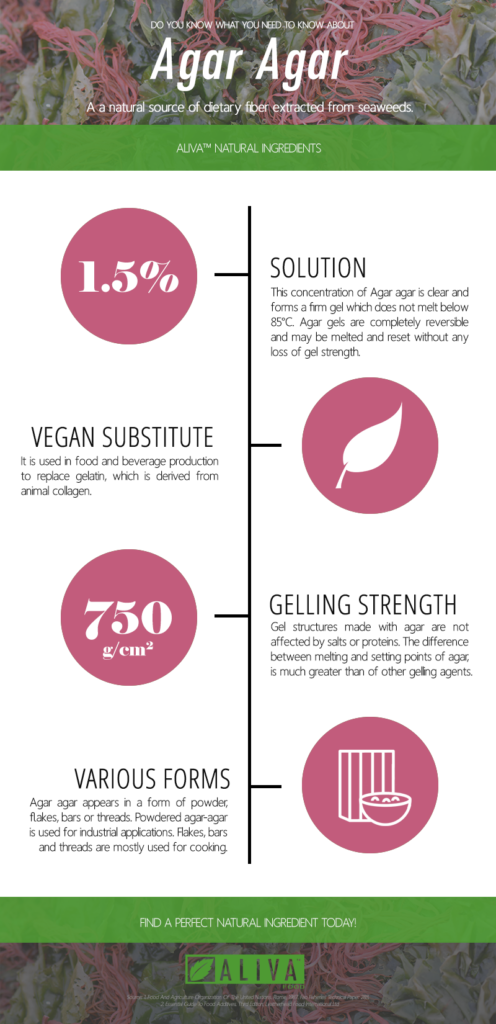Agar is a hydrophilic colloid, it can be in powder form or in a form of strips or flakes. It is insoluble in cold water and easily soluble in hot water. The agar color ranges from white to light yellow, with a gel texture, odorless or slightly marine odor. Good quality Agar-Agar powder looks like potato starch and should not stick. It is used in very small quantities and might be considered as a very technical and complicated product to apply. It is extracted from the red seaweeds Agarophytes, such as Gelidium (Gelidiaceae), Gracilaria (Gracilariaceae), Pterocladia (Gelidiaceae), and Ahnfeltia (Phyllophoraceae), based on the country of the origin.
Agar-agar Powder
Our Agar-agar is made from selected high-quality natural Gracilaria, and Gelidium seaweed, and uses scientific methods to extract the natural polysaccharides. Agar-agar is widely used in the food industry, pharmaceutical industry, and personal care industry (for ingredients binding and viscosity controlling), biological engineering (ecofriendly products, plastic alternative, etc), biomedicine (it can be used as a carrier, a laxative, and a microorganism culture medium) and other fields.
It was first discovered as a food additive, and nowadays Agar-agar’s known properties are:
- Emulsifier – Most manufacturers, especially pastry chefs, use it as a powder to incorporate it more easily, for example in flour.
- Gelling agent – Agar-agar is the most powerful gelling agent, its action is perceptible at 0.1%; It gives more firmness compared to gelatin, and enables to serve warm mousses.
- Bulking agent in bread and cakes in addition to its non-calorific dietary fiber properties;
- Glazing agent – Agar-agar helps to make shiny and protective coatings, increasing the viscosity of the glaze and improving its adhesion to the doughnut. In addition, it prevents the glaze from melting.
- Humectant – in some meat products Agar-agar retains the water and prevents evaporation and drying of a product.
- Stabilizer – Agar-agar is applied in various desserts, it stabilizes foams, icings and helps keep the substances’ uniform dispersal.
- Thickener – Agar-agar is a well known plant-based thickening agent, improving foodstuffs’ texture and viscosity.
As a gelling agent, binder and thickener of vegetable origin, perfect for animal gelatin, Agar-agar is widely used in Muslim countries. As one of the strong gelling agents, Agar-agar is widely used in the food industry, such as suspending agents, thickeners, stabilizers and clarifiers. Soft candies made from Agar-agar have a refreshing taste and high transparency that is better than normal jelly.
Applications of Agar-agar in Food Processing
- Pastry, confectionery and bakery:
- Fruit mousses, chocolate and vanilla mousses
- Cakes and donuts
- Icing and glazes
- Macarons
- Chocolates
- Jellies
- Candies and candy filling
- Flans
- Pana cotta
- Jams
- French fruit jelly
- Dairy products:
- Flavored milk
- Milk drinks
- Yogurts
- Dairy desserts
- Poultry, fish and meat:
- Canned meats
- Meats in jelly.
Is Agar-agar safe to use?
The US Food and Drug Administration lists Agar-agar as a generally recognized as safe product (GRAS). As per PubChem (prev. HSDB), Agar-agar is nontoxic and despite the usual use of small doses, can be taken in larger quantities as well.
How to use Agar-agar?
Most food manufacturers do not need a heat higher than 60 degrees. With a heating over 70 degrees, this makes the product lose its gelling side.
The adequate grade for Agar-Agar used in the confection of chocolates:
- Agar-agar has to form a low concentrated gel / low gel strength
- We are looking for a short and consistent/dense texture
- The gel is formed/ forms when the temperature cools to 30-40C.
- Melting temperature has to be higher than 85-90″ c
- The gel has to be transparent, thermo-reversible and stable at low PH
Dosages
Liquid
For half a liter of liquid preparation to gel, you need 2 gr of Agar-agar powder (i.e. 1 level teaspoon). Heat the liquid with the Agar-agar and bring it to a boil for 30 seconds, then pour the liquid into a container and let cool.
Jams
1 kg of fruit, 500 g of sugar, 2 g of agar agar or a little more if the application is fruit juice. Read more about additives for fruit juices here.
Fruit paste
3 gr of agar-agar, 100 gr of sugar, 100 gr of fruit puree; 2 tbsp of lemon juice.
Every application of Agar agar requires some testing, to find the right specification for your products and business, to find the right specification of this additive it is better to consult a technical data sheet (TDS) of a supplier.
Get our TDS of Agar agar:


